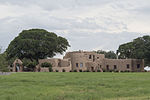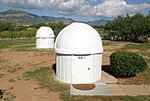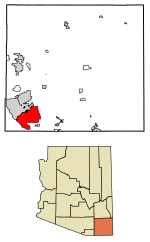Coronado Cave
Caves of ArizonaLandforms of Cochise County, ArizonaLimestone cavesWild caves

Coronado Cave (31°21′4″N 110°15′38″W) is located in Cochise County in southern Arizona near the Mexican border. Walking in the cave is rather easy and the temperature is consistent. Some rooms require crawling in order to enter. The cave has both stalactites and stalagmites. The cave has been measured to be approximately 600 feet long, 70 feet wide and 20 feet tall with several passages and crawl ways.
Excerpt from the Wikipedia article Coronado Cave (License: CC BY-SA 3.0, Authors, Images).Coronado Cave
Cave Trail,
Geographical coordinates (GPS) Address External links Nearby Places Show on map
Geographical coordinates (GPS)
| Latitude | Longitude |
|---|---|
| N 31.351111111111 ° | E -110.26055555556 ° |
Address
Coronado Cave
Cave Trail
Arizona, United States
Open on Google Maps








